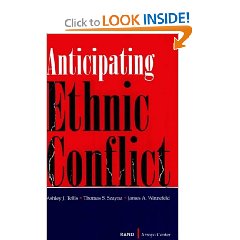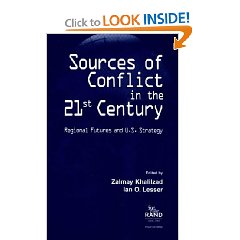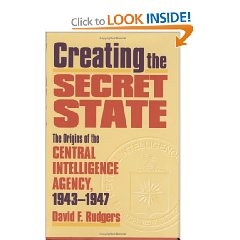Review: Anticipating Ethnic Conflict
2 Star, Culture, Research, Games, Models, & Simulations, Insurgency & Revolution, Intelligence (Government/Secret)Review: Sources of Conflict in the 21st Century–Strategic Flashpoints and U.S. Strategy
2 Star, Asymmetric, Cyber, Hacking, Odd War, Threats (Emerging & Perennial)Review: Policing the New World Disorder–Peace Operations and Public Security
4 Star, Atrocities & Genocide, Complexity & Resilience, Culture, Research, Force Structure (Military), Humanitarian Assistance, Insurgency & Revolution, Justice (Failure, Reform), Peace, Poverty, & Middle Class, Security (Including Immigration), Stabilization & Reconstruction, Threats (Emerging & Perennial), Truth & Reconciliation, Voices Lost (Indigenous, Gender, Poor, Marginalized)In excruciating detail, with substantial commonality between a number of case studies, this book examines the traditional public security (police, internal order) function in relation to failed states and external interventions.
This is not a book about the larger issue of when and how to intervene in the internal affairs of states beset by internal conflict and it is not a book about the actual conditions around the world that require some form of imposed or reinforced public order. Rather, it is the most detailed book one could hope for on the need for an international law enforcement reserve that is capable of rapidly filling the gap in local public police services that occurs when the indigenous capability collapses and traditional military forces arrive unprepared to meet this need.
All of the case studies are world-class, with primary source detail unlike any normally seen in the literature. All agree that this is a “force structure” issue that no government and certainly not the United Nations, has mastered, but most give due credit to UN civilian police operations for being the best available model upon which to build a future capability.
The summary of conclusions by Ambassador Oakley and Colonel Professor Dziedzic are alone worth the price of the book. If the Cold War era might be said to have revolved around early perceptions of a “missile gap”, the 21st Century with its Operations Other Than War (OOTW) could reasonably be said to have two issues-natural conditions such as depleted water resources, which is not the book's focus, and the “globo-cop gap”, which is-the book documents in a very compelling manner the fact that there is a major capabilities (and intelligence) chasm between preventive diplomacy on the one side, and armed military forces on the other, and that closure of this gap is essential if we are to improve our prospects for rescuing and maintaining public order around the world.
The capabilities of U.S. military police and civil affairs specialists are touched on by several pieces, but I for one would have liked to see more emphasis on what changes in their force structure is required-my understanding is that we have not increased their numbers in the aftermath of the Cold War despite the fact that these units are being used up all over the world, without relief.
The conclusion highlights the need for constabulary forces, and helpfully identifies the following specific national capabilities as being relevant (in this reader's interpretation) to a future standing international gendarmerie: U.S. Military Police and Special Forces, French gendarmerie, Spanish Guardia Civil, Chilean carabineros, Argentine gendarmes, Italian carabinieri, Dutch Royal Mariechaussee). I would add the Belgian Gendarme, the first national force to establish an open source intelligence network across all police precincts in the entire country.
It is clear from both the conclusion and the case studies that this constabulary-police capabilities requirement needs agreed-upon international concepts, doctrine, training, earmarked resources including surge capabilities and transport, and so on. We do not appear to have learned any lasting lessons from the various interventions, in that civil affairs and military police continue to be “last in line” for embarkation into areas where military forces are being introduced, and there is no U.S. program within Program 150 where we can demonstrate a real commitment to “law and order” as part of our contribution to peace in the 21st Century.
The book lacks an index, a typical shortcoming of think tank and defense educational institutions, and this is a major flaw that should be corrected in the next printing. This book is “Ref A” for every foreign service, military, and law enforcement officer interested in doing a better job of integrating diplomatic, gendarmerie, and military capabilities in every clime and place.
See also:
Breaking the Real Axis of Evil: How to Oust the World's Last Dictators by 2025
See No Evil: The True Story of a Ground Soldier in the CIA's War on Terrorism
Sleeping with the Devil: How Washington Sold Our Soul for Saudi Crude
Deliver Us from Evil: Peacekeepers, Warlords and a World of Endless Conflict
The Unconquerable World: Power, Nonviolence, and the Will of the People
The Sorrows of Empire: Militarism, Secrecy, and the End of the Republic (The American Empire Project)
War of the Flea: The Classic Study of Guerrilla Warfare
The Road to 9/11: Wealth, Empire, and the Future of America
Review: Creating the Secret State–The Origins of the Central Intelligence Agency, 1943-1947
5 Star, Empire, Sorrows, Hubris, Blowback, Executive (Partisan Failure, Reform), Intelligence (Government/Secret)Review: Andrew Jackson Higgins and the Boats That Won World War II
5 Star, Biography & Memoirs, Change & Innovation, Force Structure (Military)I wish every doctoral dissertation were this useful. Under the guidance of Stephen E. Ambrose, well known for his books on the citizen-soldiers of World War II, the author has produced a very readable and moving book about one brilliant caustic citizen's forgotten contributions to World War II. Two aspects of this book jump out at the reader: the first is that Americans are capable of anything when motivated. Andrew Jackson Higgins and his employees, most trained overnight for jobs they never thought to have, was able to create an assembly line producing one ship a day. He was able to design, build and test gun boats and landing craft on an overnight basis. He is remembered by Marines, and especially General Victor Krulak, for having given America the one missing ingredient necessary for successful amphibious landings-in this way, he may well have changed the course of the war and the history of our Nation. The second aspect that jumps out at the reader is that of bureaucratic pettiness to the point of selfishly undermining the war effort within the Department of the Navy and the Bureau of Boats. In careful and measured detail, the author lays out the history of competition between trained naval architects with closed minds, and the relatively under-trained Higgins team with new ideas, and shows how the bureaucracy often conspired to block and demean Higgins at the expense of the Marines and the sailors on the front line. There is less of that sort of thing these days, but it is still with us, as we contemplate the need for a 450-ship Navy that is fully capable for Operations Other Than War (OOTW). This book should be included on the Commandant of the Marine Corps and the Chief of Naval Operations lists of recommended professional readings, and it should be studied by anyone contemplating the hidden dangers of bureaucratic interests that often override the public interest and undermine our national security.

Review: A Half Penny on the Federal Dollar–The Future of Development Aid
4 Star, Budget Process & Politics, Disaster Relief, Humanitarian Assistance, Stabilization & Reconstruction1) Foreign aid is not preventing conflicts from emerging (if anything, and this is not implied by O'Hanlon but is explicit in William Shawcross' book DELIVER US FROM EVIL: Peacekeepers, Warlords and a World of Endless Conflict (Simon & Schuster, 2000), foreign aid contributes to instability by giving rise to warlords and black markets);
2) Foreign aid is of limited use in reconstructing societies ravaged by conflict, especially those with limited infrastructures that cannot absorb resources as well as European nations;
3) Foreign aid's best return on investment appears to be the education of women-even a few years of education has a considerable impact on birth control, health, and other areas of interest;
4)Foreign aid shapes both our own philosophy of foreign affairs, and the perceptions others have of our foreign role-it also shapes our domestic constituencies perception of why we should have a foreign policy arm;
5) Foreign aid does not play a significant role in most countries where there is access to open markets and stability does not frighten away investors-indeed the emerging expert consensus appears to lean toward debt forgiveness combined with private capital investment as the best approach to economic reform;
6) Foreign aid is least effective in those countries that are either unstable or have a range of harmful economic policies including trade barriers, large budget deficits, oversized public sectors, and overvalued exchange rates. Roughly half the countries receiving aid today have poor economic policies in place;
7) The U.S. is the least generous of the Office of Economic Cooperation and Development (OECD) members, providing just over one third as much of its Gross Domestic Product (GDP) as the other OECD countries-0.10 percent instead of 0.27 percent.
Having said all this, the author's document their views that our ODA investments need to rise from $9 billion to at least $12 billion a year, with other countries increasing their combined contributions from $51 billion to $68 billion per year. The authors favor increased foreign aid investments in poor countries with good economic policies, for the purpose of building transportation infrastructure, enhancing local health and education programs, and accelerating the expansion of utilities and communications services.
They also recommend a broader distribution of foreign aid for countries in conflict throughout Africa, and suggest that Public Law 480 food aid should be focused only on responding to disaster relief rather than indiscriminate distribution that benefits U.S. farmers but undermines foreign agricultural programs.
They conclude with the somewhat veiled suggestion that all of this could be paid for by a reduction of foreign military assistance to Egypt and Israel. One is left, at the end of the book, with two strong feelings: first, that U.S. foreign aid is on “automatic pilot” and rather mindlessly muddling along; and second, that this is a very small but very important part of the total U.S. national security budget, one that merits its own ombudsman within the National Security Council, and one that is worthy of no less than a penny on the dollar as we plan our future Federal investments.
What is left unsaid by the authors is whether the other $60-80 billion in foreign aid by various actors including the United Nations agencies, is well managed–one is left with the impression that the U.S. really faces two challenges: an internal challenge of improving its performance with respect to foreign aid, and an external challenge in demanding a more rational and coordinated approach to various forms of aid being sponsored by others.









